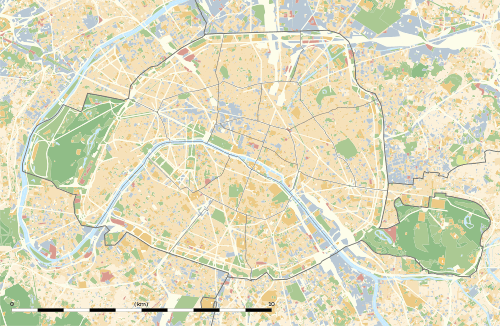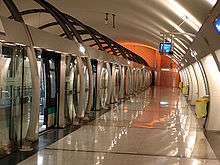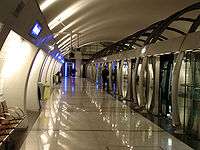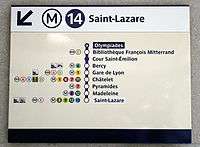Olympiades (Paris Métro)
| Paris Métro station | |||||||||||
 | |||||||||||
| Location |
13th arrondissement of Paris Île-de-France France | ||||||||||
| Coordinates | 48°49′38″N 2°22′06″E / 48.82722°N 2.36833°ECoordinates: 48°49′38″N 2°22′06″E / 48.82722°N 2.36833°E | ||||||||||
| Owned by | RATP | ||||||||||
| Operated by | RATP | ||||||||||
| Construction | |||||||||||
| Disabled access | Yes | ||||||||||
| Other information | |||||||||||
| Fare zone | 1 | ||||||||||
| History | |||||||||||
| Opened | 2007 | ||||||||||
| Services | |||||||||||
| |||||||||||
| Location | |||||||||||
 Olympiades Location within Paris | |||||||||||
Olympiades is a station of the Paris Métro. It is the southern terminus of Line 14.
The station was formally inaugurated on June 25, 2007 in the presence of the Mayor of Paris, Bertrand Delanoë,[1] and opened to the general public at just before 5.30am on June 26, 2007.[2]
It takes its name from the area of high-rise residential tower blocks known as Les Olympiades in the heart of Paris's 13th arrondissement, to the east of the station Tolbiac, a quarter of Paris that was previously poorly served by the Metro. This area also contains the Tolbiac centre of the University of Paris. Since the opening of the new station, residents of this area, as well as staff and students at the university, can now access Saint Lazare railway station in 13 minutes and the centre of Paris in around 10 minutes.
The station entrance is at the intersection of the rue de Tolbiac and the rue Nationale.
History
Originally called "Tolbiac-Nationale" in the initial Line 14 project, the opening of this station as part of the link between Saint Lazare and Maison Blanche station, was delayed due to a financial shortfall. The plans for Line 14 were revised and a first stage was embarked upon, in which the line ran from Madeleine to Bibliothèque François Mitterrand. This section was opened in 1998, from which the present station Olympiades was used as a temporary maintenance facility.
A new extension of the line of 676 metres was later decided upon and allocated funds; the maintenance facility was moved further down the tunnel. Like the rest of Line 14, the extension is essentially composed of a monotubular tunnel containing two tracks, one for each direction.
The extension was delayed by almost a year after its construction caused the collapse of the playground of Auguste-Perret school, located above one of the underground facilities. Further problems were encountered with the extension's automatisation.
The chosen name provoked tensions between the RATP (the Parisian transport authority), the city of Paris and the Comité National Olympique et Sportif Français (French National Olympic and Sport Committee), which owned the name. An agreement reached at the start of July 2006 found a compromise by allowing the use of this name within the restricted context of public transport.
Architecture
The station's architecture is in keeping with the other stations of Line 14. It is marked by concrete vaults as well as a high ceiling and platforms that are wider than average in the Paris Metro system.
Future
Olympiades will remain the terminus of Line 14 for several years. In the future (around 2020-2030) the line is expected to be extended to Maison Blanche to facilitate a connection with Line 7. It may also take over one of Line 7's branches, to either Villejuif or Ivry. The transport project of the Grand Paris plans a terminus near the Institut Gustave Roussy, in Villejuif.[3]
Station layout
| G | Street Level | Exit/Entrance |
| B1 | Mezzanine | to Exits/Entrances |
| B2 | ||
| Southbound | ← | |
| Northbound | ← | |
Gallery
 Line 14 platforms at Olympiades
Line 14 platforms at Olympiades Line 14 platforms at Olympiades
Line 14 platforms at Olympiades Line 14 platforms at Olympiades
Line 14 platforms at Olympiades.jpg) View of Olympiades from MP 89 train
View of Olympiades from MP 89 train Platform signage at Olympiades
Platform signage at Olympiades Line 14 map at Olympiades
Line 14 map at Olympiades
See also
References
- ↑ Métropole - Olympiades : fini de jouer
- ↑ RATP - Extension réseau
- ↑ "Le grand pari de l'agglomération parsienne". french government. Retrieved 24 March 2011.
External links
| Wikimedia Commons has media related to Olympiades (Paris Metro). |
| Paris Métro | Line 14 | |
|---|---|---|